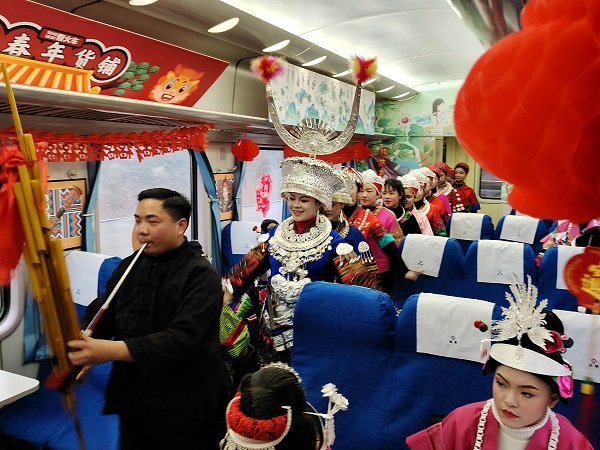The carriage of traditional culture


The green train is transformed into a lively and festive venue, with actors wearing traditional clothing greeting passengers with rice wine. It is one of the few remaining green train routes in the country, since most have been gradually replaced by high-speed railways. [Photo/VCG]
Unique train taps into national trend toward celebrating vibrant rural customs during major festivals
On Jan 26, in the Qiandongnan Miao and Dong autonomous prefecture in Guizhou province, a slow green train set off on a routine journey, albeit one with a remarkable twist.
To the beautiful melodies of folk songs and the jovial laughter of passengers, the train's interior was transformed into a lively and festive venue. As one of the events marking this year's national cunwan (countryside gala) project for Spring Festival, launched by the Ministry of Culture and Tourism, performers ingeniously used the carriages as a mobile stage, and delivered splendid performances to passengers traveling along the route.
Operating between Guiyang and the province's Yuping Dong autonomous county in Tongren since 1997, it is one of the few remaining green train routes in the country, with most having been replaced by high-speed railways.
Despite the slow speed, for villagers along the route, the train represents not only a means of visiting friends and relatives, but is also a vital link for transporting agricultural products to markets beyond the mountains.
Starting Jan 26, the beginning of this year's Spring Festival travel season, local authorities decided to turn the train into a brand by integrating agricultural, cultural, sports, tourism and commercial experiences along its 337-kilometer route.
The reconfigured train now has themed carriages, including an intangible cultural heritage workshop, a mobile library and a county fair. The gala will also be regularly performed, and will serve as a mobile stage to present a vibrant and lively picture of rural vitalization.
In recent years, countryside galas, rural basketball and soccer events, as well as other cultural activities, have become an emerging trend in the integrated development of the cultural and tourism sectors. They not only stimulate spending, but also promote rural culture.
Besides Guizhou, countryside galas featuring entertainment shows with rural characteristics have become a Chinese New Year custom beloved of countryside communities across the nation.
Rao Quan, vice-minister of culture and tourism, says that, by demonstrating the unique culture of the countryside, these galas will become a golden brand, boosting rural tourism and the countryside economy.
Wang Xiaozhen, vice-president of the China Media Group, says that countryside galas offer a vibrant array of performances brimming with the vitality of rural life, which recount the splendor of farmers and rural culture in the new era.
The country's first countryside Spring Festival gala was held in Lishui in Zhejiang province in 1981, when villagers in Yueshan village in Qingyuan county, built a stage to perform local operas and lantern dances. It preceded than the annual Spring Festival Gala organized by China Central Television by two years.
The 14th Five-Year Plan (2021-25) for cultural and tourism development highlights countryside galas as an innovative way of carrying on traditional culture, especially during holidays like the Spring Festival.







